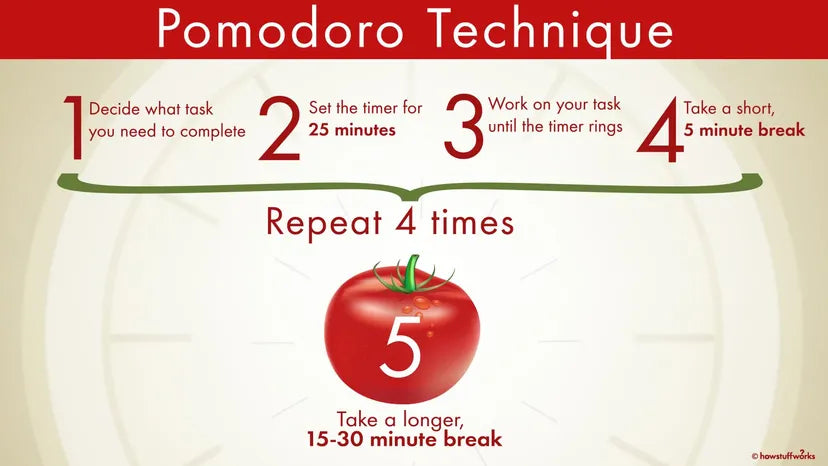Understanding The Pomodoro Technique: Simple Steps To Boost Your Focus
Researcher in mindfulness and its effects on productivity.

Researcher in mindfulness and its effects on productivity.

— in Stress Management
— in Tai Chi
— in Mindfulness
— in Mindfulness
— in Productivity
The Pomodoro Technique is a popular time management method. It was developed by Francesco Cirillo in the late 1980s.
Francesco Cirillo, a university student, struggled with focus and completing assignments. He used a tomato-shaped kitchen timer to time himself, committing to just 10 minutes of focused study time. This simple method helped him, and thus, the Pomodoro Technique was born. "Pomodoro" is Italian for "tomato,".
The technique involves 25-minute work sessions called "Pomodoros". These sessions are separated by 5-minute breaks. After four Pomodoros, you take a longer 15-30 minute break.

Effective time management is crucial for productivity. It helps you prioritize tasks, stay organized, and accomplish more in less time. The Pomodoro Technique offers a structured approach to time management. This can significantly enhance your ability to focus and achieve your goals.
This technique offers several benefits that can significantly enhance your productivity.
Working in short, focused bursts helps improve concentration. The Pomodoro Technique's structure minimizes distractions and keeps you engaged in the task at hand.
Breaking down large tasks into smaller, manageable Pomodoros makes them less daunting. This can help reduce procrastination and the anxiety associated with overwhelming workloads. Studies have shown an effective way to break out of the avoidance cycle: shrink whatever it is you're putting off down to a tiny, unintimidating first step.
Regularly using the Pomodoro Technique helps you become more aware of how you spend your time. It allows you to make better estimates for task completion. You can plan your day more effectively.
The sense of urgency created by the timer can boost your efficiency. The structured breaks help maintain your energy levels. This leads to higher task completion rates.
The Pomodoro Technique can be particularly effective for studying.
Break down your study material into smaller, manageable chunks. Allocate a certain number of Pomodoros to each chunk. This creates a clear study plan.

Minimize distractions in your study area. Turn off notifications on your phone. Inform those around you that you are using the Pomodoro method. This can help reduce interruptions and external distractions. Using mindfulness techniques can also enhance focus.
While the traditional 25/5 interval works well for many, you can adjust the timings. You can customize them to suit your needs. Some people find longer work intervals, such as 45 or 50 minutes, more effective.
Reading textbook chapters or reviewing lecture notes are great examples. Solving practice problems or creating flashcards are also good examples. Memorizing key concepts or writing essays can be done using Pomodoros.
Several apps can help you implement the Pomodoro Technique more effectively.
Forest is a unique app that gamifies the Pomodoro Technique. You plant a virtual tree when you start a Pomodoro. The tree grows as you work. If you leave the app, the tree dies. This encourages you to stay focused. It also helps you build a virtual forest over time.
Pomodor is a minimalist web-based timer. It's perfect for those who want a simple, no-frills tool. Just hit the "Play" button, and it cycles through Pomodoro sessions.
Focus Keeper is designed for iOS devices. It offers customizable timers. It provides detailed reports to track your productivity.
Toggl Track combines time tracking with the Pomodoro Technique. It's ideal for freelancers and anyone who needs to track billable hours. It also integrates with other productivity tools. Toggl Track integrates with Zapier. You can do things like create calendar events from new time entries.
Look for customizable timers and the ability to track your progress. Integration with other productivity tools is a plus. A clean, user-friendly interface is essential. Choose an app that suits your preferences and workflow.
To maximize the benefits of the Pomodoro Technique, consider these tips.
Before starting each Pomodoro, define a specific goal. This helps maintain focus. It provides a sense of accomplishment when the timer rings.
Minimize interruptions by turning off notifications. Communicate your need for focused time to those around you. If an interruption occurs, take note of it. Address it during your break or after the Pomodoro session.

Use your breaks to step away from your work. Stretch, take a short walk, or do something relaxing. Avoid activities that are too engaging or difficult to stop. Simple breathing exercises can also help you relax and refocus during breaks.
The standard 25/5 interval is a starting point. Adjust the timings to find what works best for you. You might prefer longer work sessions or shorter breaks.
The Pomodoro Technique is a simple yet powerful time management method. It can significantly improve your focus and productivity. It breaks work into manageable intervals and incorporates regular breaks. The technique helps you stay on track and achieve your goals.
The Pomodoro Technique involves 25-minute work sessions followed by 5-minute breaks. After four Pomodoros, take a longer 15-30 minute break. Customize the intervals to suit your needs. Use apps like Forest, Pomodor, Focus Keeper, or Toggl Track to enhance your experience. Set clear goals, manage distractions, take meaningful breaks, and adapt the technique to your workflow.
Try the Pomodoro Technique and see how it impacts your productivity. Experiment with different timings and apps to find the perfect setup. You might be surprised at how much more you can accomplish. You can also try incorporating Zen practices into your daily routine for a more balanced and productive life.